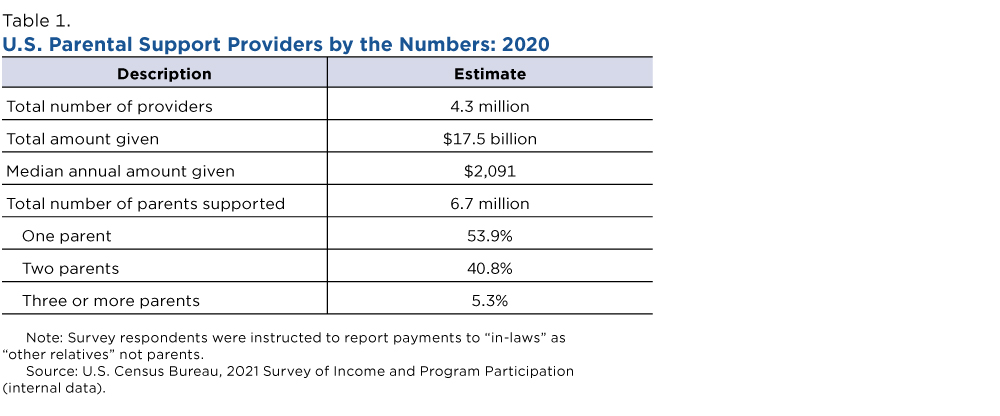Number Who Helped Parents Financially Almost as High as Number Who Paid Child Support
Roughly 4.3 million U.S. adults provided voluntary financial support to parents in 2020 — almost as many as the 4.4 million who made mandatory child support payments.
But the amount of money spent on parental support was significantly lower: $17.5 billion compared to $30.6 billion for child support, according to the U.S. Census Bureau’s 2021 Survey of Income and Program Participation (SIPP).
In 2020, about 2.4 million U.S. parents received an average of more than $2,000 (median annual payment of $3,749) from adult children.
Money given to parents fell by roughly $9 billion from 2019 to 2020, a year that included the first nine months of the COVID-19 pandemic.
Estimates from the 2014-2021 SIPP show that over this eight-year period, annual support provided to parents ranged from a low of $10.4 billion in 2014 to a high of $27.9 billion in 2018 (Figure 1).
Since this financial support is voluntary, a fluctuation in annual amounts is expected. However, the drop in support in 2020 may be explained by financial hardship during the pandemic, limiting the amount people could give to parents.
Large Share of Payments to Those Living Outside the Household Went to Parents
In 2020, approximately 8.7 million people provided $48.6 billion to support individuals who lived outside their households, including parents and grown children. These providers who voluntarily gave monetary support to people living elsewhere do not include those who gave mandated support in the form of child support or alimony.
Voluntary support can come in the form of regular or lump sum payments. In 2020, U.S. support providers made voluntary payments to:
- 6.7 million parents ($17.5 billion).
- 3.1 million adult children ages 21 or older who were not away at school ($17.6 billion).
- 4.0 million relatives other than parents and adult children ($11.0 billion).
- 1.9 million nonrelatives ($2.5 billion).
Half of all adults who made these payments to people outside their households were helping parents (4.3 million).
In 2020, about 2.4 million U.S. parents received an average of more than $2,000 (median annual payment of $3,749) from adult children.
More than half (53.9%) of parental support providers made payments to one parent and 40.8% to two parents.
When adult children report supporting only one parent, it is often because that parent is a widow or widower. Of the 2.3 million adult children who reported supporting only one parent, about 1.3 million (or 57.3 %) indicated it was because the other parent was dead.
Only 5.3% of parental support providers made payments to three or more parents (Table 1), suggesting that a minority of these households were supporting both parents and stepparents. (Payments made to parents-in-law are reported in the SIPP as payments to “other relatives.”)
Who Provided Parental Support?
Those who provided parental support differed demographically from those who did not. They were generally younger (average age 42 vs. 47) and more likely:
- To be men (57.7% vs. 48.3%).
- To be employed (89.7% vs. 62.8%).
- To be married (63.2% vs. 48.1%).
- To have a bachelor’s degree (39.0% vs. 34.0%).
Roughly half (45.9%) of those who provided voluntary support to parents living elsewhere were non-citizens. And among those who were U.S. citizens, around 43% were naturalized, suggesting parental giving was more common among immigrants or those who came from immigrant families.
Among supported parents, 62.4% come from only five countries, with most supported parents having been born in either Mexico (26.0%) or the United States (22.3%). Three of these leading five countries of origin are in Latin America (Mexico, El Salvador, and the Dominican Republic) and accounted for 33.0% of supported parents.
Additionally, about half (50.2%) of those who provided support to their parents in 2020 were Hispanic. A possible explanation: the parents of 94.3% of Hispanic parental support providers were born in Latin American countries where a considerable share of the older population lacks retirement benefits, according to a 2021 report from the International Labour Organization, a United Nations agency. So these parents may rely on their children for financial support in their retirement years. Around 59.2% of Hispanic parental support providers had at least one parent who was born in Mexico.
About the SIPP
The SIPP is a nationally representative, longitudinal survey administered by the Census Bureau that provides comprehensive information on the dynamics of income, employment, household composition and government program participation.
More information is available on the SIPP webpage. Technical documentation and more information about SIPP data quality are on the SIPP Technical Documentation webpage. The estimates presented here are subject to sampling and nonsampling error.
Related Statistics
-
Stats for StoriesNational Parents’ Day: July 23, 2023Of the 63.2M parents living with their children <18, 76.1% lived with a spouse, 15.1% had no spouse/partner present. The rest lived with a cohabiting partner.
-
Stats for StoriesNational Single Parent Day: March 21, 2024The Current Population Survey (CPS) estimates there were 9.8M one-parent households (7.3M mother only and 2.5M father only) in 2023, compared to 1.5M in 1950.
-
Stats for StoriesMother’s Day: May 14, 2023The June 2020 Fertility Supplement to the Current Population Survey estimated out of 76M women ages 15 to 50, 41M were mothers who had 89M children ever born.
-
Stats for StoriesFather’s Day: June 18, 2023Over one in four men — 34.3 million — have a biological child who is under 18. Four out of five of these fathers live with some of those children (79.8%).
Subscribe
Our email newsletter is sent out on the day we publish a story. Get an alert directly in your inbox to read, share and blog about our newest stories.
Contact our Public Information Office for media inquiries or interviews.
-
America Counts StoryOver a Quarter of Children Lived With At Least One Foreign-Born ParentFebruary 03, 2022A new report reveals that children living with at least one foreign-born parent are more likely to live with two parents than children with native-born parents.
-
America Counts StoryWhen Do We Lose Our Parents?May 06, 2019People lose their fathers earlier in life than their mothers. New Census Bureau data show socio-economic factors also associated with when we lose our parents.
-
America Counts StoryParents and Children Interacted More During COVID-19January 03, 2022During Covid-19 lockdowns, parents changed how they interacted with children: more dinners and reading together but fewer outings.
-
EmploymentThe Stories Behind Census Numbers in 2025December 22, 2025A year-end review of America Counts stories on everything from families and housing to business and income.
-
Families and Living ArrangementsMore First-Time Moms Live With an Unmarried PartnerDecember 16, 2025About a quarter of all first-time mothers were cohabiting at the time of childbirth in the early 2020s. College-educated moms were more likely to be married.
-
Business and EconomyState Governments Parlay Sports Betting Into Tax WindfallDecember 10, 2025Total state-level sports betting tax revenues has increased 382% since the third quarter of 2021, when data collection began.
-
EmploymentU.S. Workforce is Aging, Especially in Some FirmsDecember 02, 2025Firms in sectors like utilities and manufacturing and states like Maine are more likely to have a high share of workers over age 55.







